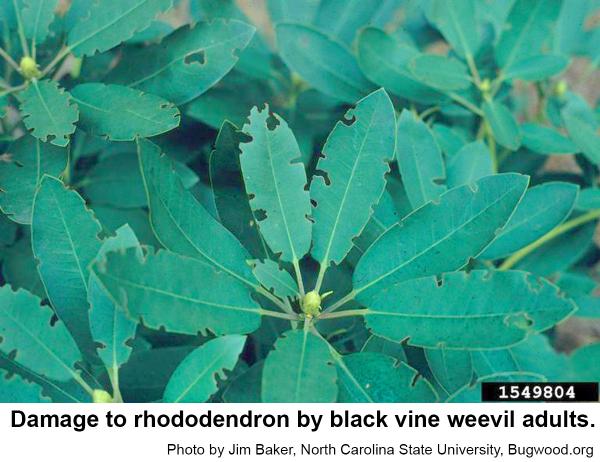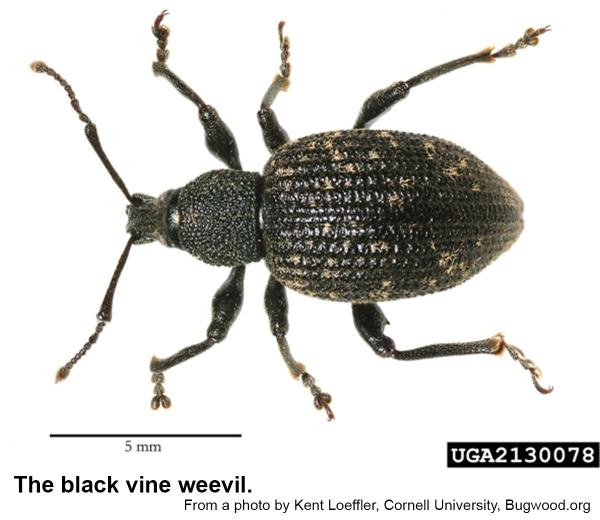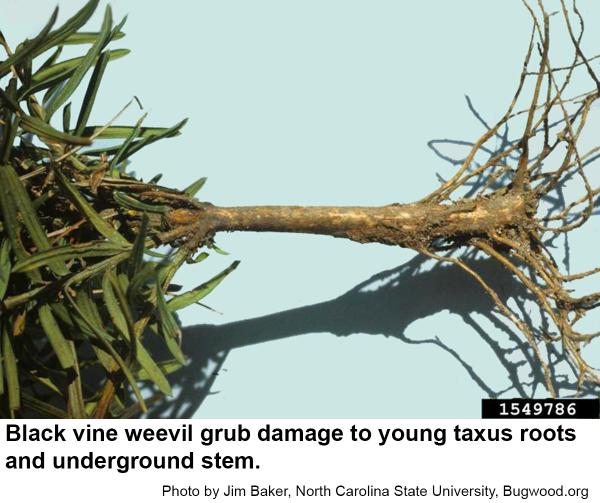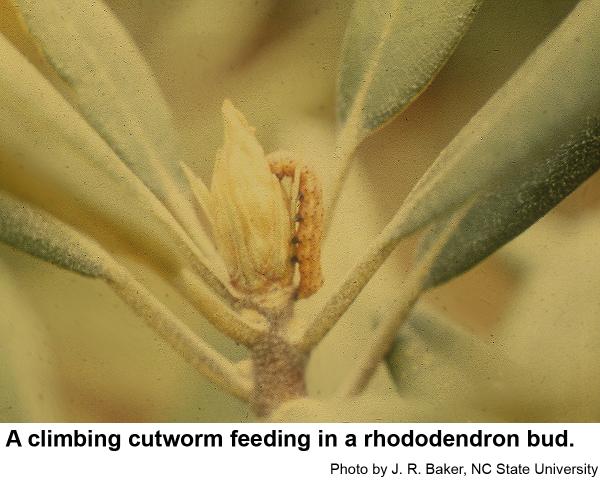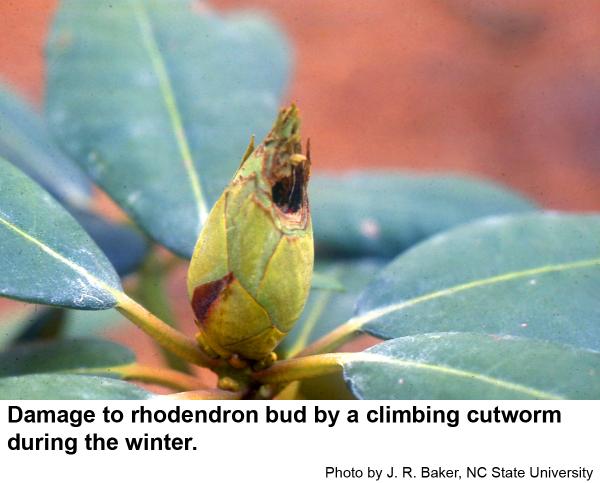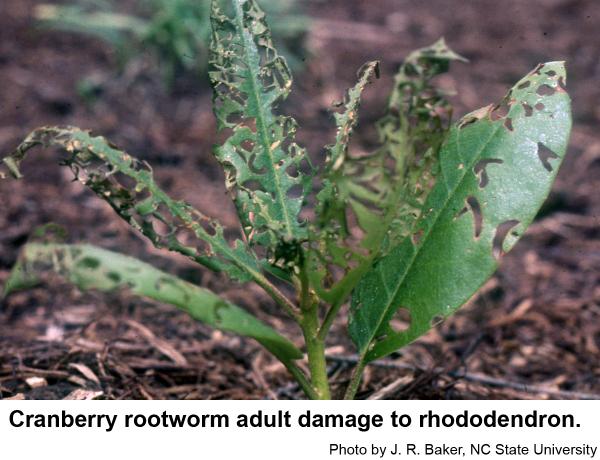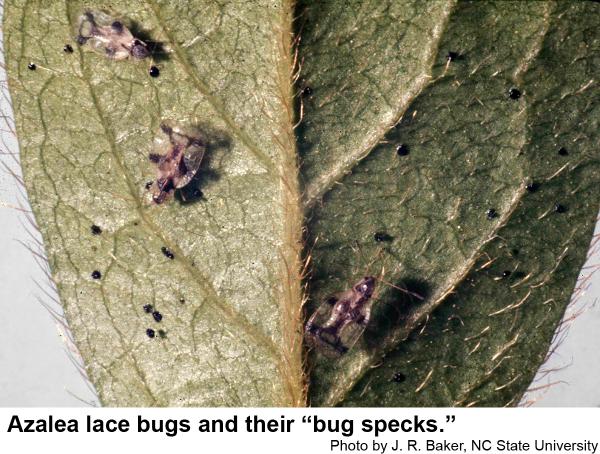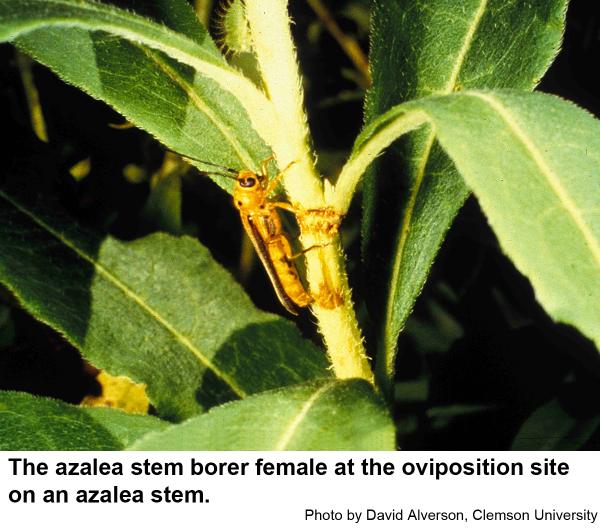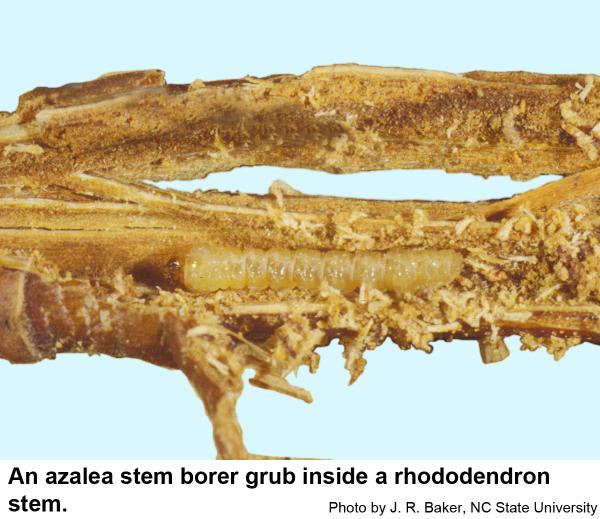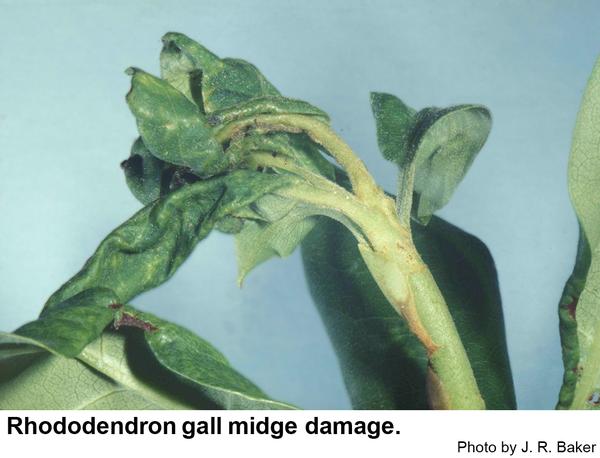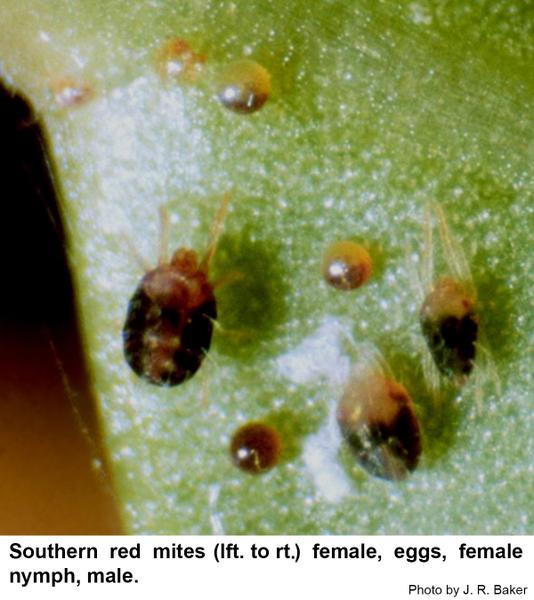Caution
This information was developed for North Carolina and may not apply to other areas.
A number of arthropods attack rhododendron, but some pests such as aphids, whiteflies, and scale that are problems in other parts of the country, are uncommon in North Carolina. Here are our most common pests. This information is just for quick reference. Consult the links in Other Resources below for more complete information and control options.
Azalea Caterpillar
Symptoms and Diagnostic Information
- "U" posture when disturbed.
- Red head. Yellowish with black stripes. Stripes "broken" on older larvae.
- Generally feed in groups. Typically late summer / early fall.
- Occasional pest. One generation.
Management Suggestions
- Knock off or pick off and destroy.
- B.t. if small, pyrethroid, Sevin, or other.
Black Vine Weevil
Symptoms and Diagnostic Information
- Larvae are legless grubs.
- Larvae feed on roots of many herbaceous and woody hosts. Larger roots stripped or girdled.
- The adult weevils chew the edges of older leaves.
- Overwinter as mature larvae or pupae in soil. However, a few adults also survive the winter to feed and deposit eggs during a second season.
- Flightless adults, females need not mate.
- Adults usually live approximately 90 to 100 days.
- Adults feed at night and drop from the plant when disturbed.
Management Suggestions
- Imidacloprid soil / media drench.
- Scimitar + Demand; Talstar; Aloft. Three treatments.
- Timing with bloom important.
- Predatory nematodes helpful.
- Resistant varieties.
Climbing Cutworms
Symptoms and Diagnostic Information
- Smooth-skinned owlet moth caterpillars with various markings.
- Several species, many hosts.
- Climb shrubs at night to feed on buds and new growth.
- Pupate in soil; some species have multiple generations.
- Curl into a "C" when disturbed.
- Active late spring-summer, mild winter days.
Management Suggestions
- Acelepryn, pyrethroid, Sevin or some other contact insecticide should give adequate control of climbing cutworms.
- Disturbance of duff / mulch, and stem barriers may be helpful.
Cranberry Rootworm
Symptoms and Diagnostic Information
- Common on cranberry and rhododendron, but many other hosts.
- Adult, shiny brown / bronze. First appear about June.
- Larvae feed on roots and runners.
- Adults feed on leaves from underside, at night.
- Characteristic curved or "boomerang" shaped holes.
Management Suggestions
- Imidacloprid soil drench.
- Pyrethroid spray undersides of leaves.
- Beneficial nematodes in soil.
Rhododendron Borer
Symptoms and Diagnostic Information
- Leaves may brown.
- Slender yellow-white larva found inside stem.
- Infested twigs break off or wilt and die.
- Adults emerge May-June; small black moth w/ white & yellow markings.
- Eggs deposited on twigs.
- Reddish frass evident in tunnel.
Management Suggestions
- Prune out and destroy infested parts.
- Protective bole and base sprays in spring with Astro or Onyx.
- Astro or Onyx foliar sprays in early spring for foliage feeding damage.
Rhododendron & Azalea Lace Bug
Symptoms and Diagnostic Information
- Adult with lacey wings, 1/8" long.
- Feed from underside of leaves.
- Upper leaf surface white stippling to splotchy.
- Underside leaf surface with black fly-speck-like fecal spots.
- Adults and spiny nymphs on underside of leaf.
- Overwinters as egg within leaf at leaf vein.
- Egg hatch begins early Spring. 2-3 generations.
Management Suggestions
- Reduce stress of plant.
- Spray underside of leaves with malathion, orthene, pyrethroid or use imidacloprid systemic soil drench.
Rhododendron Stem Borer (also called Blueberry Stem Borer and Azalea Stem Borer)
Symptoms and Diagnostic Information
- Dark beetles 5/8". Long antennae, pale yellow with two black spots behind head.
- Lay eggs in new shoots below the bud. June-July.
- Larvae bore down core of twig where they overwinter.
- Two-year life cycle.
- Adults feed on undersides of leaves causing leaves to curl.
- Boring by larvae causes wilting and dieback of individual stems.
- Sawdust-like debris around small entrance holes in the bark.
Management Suggestions
- Prune and destroy wilting branches.
- If adults are seen in the previous year, spray the branches with permethrin.
Rhododendron Tip (Or Gall) Midge
Symptoms and Diagnostic Information
- Light brown midge, 1.25 mm long. Larva is whitish, flattened maggot almost 1/16 inch long.
- Uncommon in North Carolina. Rhododendron only known host.
- Maggots feed exclusively on tender, new growth.
- Leaves inwardly-rolled with swollen, greenish-yellow tissue.
- Pale green bulges on leaves, stunted and distorted.
- Overwinter as pupae in the soil. The adult flies emerge and lay eggs in the spring as new plant growth develops.
- Damage late May or early June. May reappear on second flush of growth.
- Heavy infestations of this pest are unusual and sporadic.
Management Suggestions
- Remove and destroy newly infested foliage. This practice may eliminate an infestation within a year or two.
- Imidacloprid, dinotefuran, or orthene as spray or soil drench effective if applied prior or very early.
Southern Red Mite
Symptoms and Diagnostic Information
- Discoloration noted during summer or winter.
- Tiny chlorotic spots.
- Flattened oval eggs with central thread (or clear egg shells) present in summer and winter .
- Mites almost black body with pale yellow-brown legs.
- All stages on underside of leaves.
- Use 10X hand lens to check.
Management Suggestions
- Horticultural oil, Floramite, Hexygon, sprayed in cool season while mites active. Follow-up sprays may be required with oil.
Alternative plant suggestions - barberry, mahonia, pieris
Recommendations for the use of chemicals are included in this publication as a convenience to the reader. The use of brand names and any mention or listing of commercial products or services in this publication does not imply endorsement by the N.C. Cooperative Extension nor discrimination against similar products or services not mentioned. Individuals who use chemicals are responsible for ensuring that the intended use complies with current regulations and conforms to the product label. Be sure to obtain current information about usage and examine a current product label before applying any chemical.
Other Resources
- Insect and Related Pests of Shrubs. Baker, J. R. ed. 1980. NC State Extension pub. AG-189.
- Rhododendron Pest Management Calendar. Frank, S. and J. Baker. 2019 (revised). Entomology Insect Notes, NC State Extension Publications
- NC State Extension Plant Pathology Publications
- NC State Horticultural Science Publications
- North Carolina Agricultural Chemicals Manual
For assistance with a specific problem, contact your local N.C. Cooperative Extension center.
Publication date: Oct. 25, 2018
Recommendations for the use of agricultural chemicals are included in this publication as a convenience to the reader. The use of brand names and any mention or listing of commercial products or services in this publication does not imply endorsement by NC State University or N.C. A&T State University nor discrimination against similar products or services not mentioned. Individuals who use agricultural chemicals are responsible for ensuring that the intended use complies with current regulations and conforms to the product label. Be sure to obtain current information about usage regulations and examine a current product label before applying any chemical. For assistance, contact your local N.C. Cooperative Extension county center.
N.C. Cooperative Extension prohibits discrimination and harassment regardless of age, color, disability, family and marital status, gender identity, national origin, political beliefs, race, religion, sex (including pregnancy), sexual orientation and veteran status.


